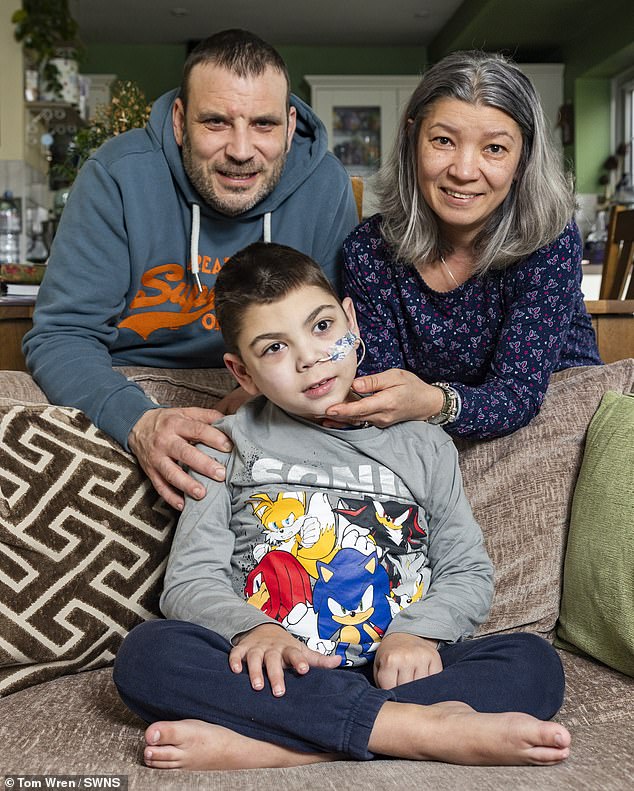We thought Minecraft was making our son sick, but the truth was much worse: parents’ pain as nine-year-old boy was told his ‘next seizure could be his last’ after being diagnosed with one of the world’s rarest diseases
A nine-year-old boy diagnosed with an extremely rare genetic disease has been told his next attack could be his last.
William Howard was originally told by doctors that his bizarre symptom – a muscle twitch in his right leg – could be due to ‘stress’ from playing Minecraft.
But after ‘endless’ medical research, tests revealed that a mitochondrial disease was actually responsible for his sudden and random twitching, which caused him to repeatedly fall over.
William is one of 10 people in the world who have his specific variation, his parents claim.
Simon, 45, and Mihaela, 43, from Swindon, say a normal, healthy little boy went from being paralyzed to seizures seemingly overnight.
William Howard, nine, (pictured) was told by doctors that his first symptom, a muscle twitch in his right leg, could be due to stress from playing Minecraft

After ‘endless’ medical testing, an MRI confirmed he has mitochondrial disease, which causes cells to not produce enough energy. His parents, Simon, 45, (left) and Mihaela, 43, (right) say he went from a normal, healthy little boy to paralysis from seizures, seemingly overnight.
Mrs Howard, a former nurse, said: ‘Doctors have told us to prepare for the worst. It could be another attack for William. We’re terrified, but he’s a fighter.
‘It’s a reason to get out of bed in the morning because it’s one more day with William.
“I’ll check on him and see that he’s asleep in his bed, and at that moment I’ll think, we have at least one more day together.”
William’s parents first noticed that his right leg had started to ‘droop’ when he tried to walk and after a while they became concerned.
Mr Howard, chef manager, called 111 and was told to take him to the GP the next day.
However, he drove him to the hospital on May 21, 2020 when he noticed he was having trouble walking to the toilet.

His parents and six-year-old sister Sofia (pictured right) were both DNA tested for the typical hereditary disease, but neither of them had the gene
“William was walking around as normal, but suddenly his leg gave out and he fell over,” Mr Howard said.
“He laughed it off, went around and it happened again. We thought he was joking about it, but then it became more consistent.
‘So we took him to hospital, where he was initially told he might have broken his coccyx.
‘They advised us to transfer him (to a specialist hospital) for further tests, so we drove him.’
Initially, doctors feared that it could possibly be due to Covid – because this was the beginning of the pandemic and doctors did not want to rule anything out.
But after a test came back negative, doctors told the couple it might be due to stress.
“William was watching crazy things about Minecraft on YouTube,” Mr. Howard said.
‘He got excited. So we thought this must be the reason.”
“He literally had his game thrown in the trash while he was at the doctor, but then the weakness started affecting his upper body.”
William was sent for further tests, but he suffered a full-body tonic-clonic seizure that causes uncontrollable stiffening and muscle twitching.
He was then put into a medically induced coma to protect his brain from damage while doctors ran more tests.
Doctors eventually diagnosed mitochondrial disease, an umbrella term that encompasses several conditions caused by defects in mitochondria – powerhouses of cells that provide our bodies with energy to function.
It is estimated that approximately one in 5,000 people has mitochondrial disease.
But William is believed to have a specific type, related to a defective protein called DNML-1.
Only nine others in the world are believed to have the same type, his family says.
There is no cure; treatments are only supportive to relieve seizures and other characteristic symptoms such as muscle weakness and visual problems.
Some patients suffer from dystonia, a movement disorder that can cause uncontrolled muscle cramps and spasms. It can also happen that parts of the body twist into unusual positions.
William was not given an official prognosis, but doctors warn any attack could be his last, his parents say.
“It took me a long time to cry and calm down,” Mrs. Howard said.
‘I had to be alone. I could not believe it.’
William was in a coma for two months and woke up in July 2020.

The couple say they were ‘grateful’ to have been able to make memories with William over the Christmas period – despite having to do it without a tree, decorations or Christmas dinner
He has since lost the ability to eat and drink and doctors say the family says the disease is slowly shutting down each of his vital organs.
After suffering another severe attack that lasted 56 minutes, he fell into a coma for the second time on December 7, 2023.
Mr Howard said: ‘He was told by the doctor that this could be it but he was only on it for a week.’
“We had prepared for the worst – on the day of his big attack he also had 13 other attacks,” Mrs Howard added.
“The doctor was really shocked that he came in after just a week – and William was even able to come out by Christmas,” she said.
